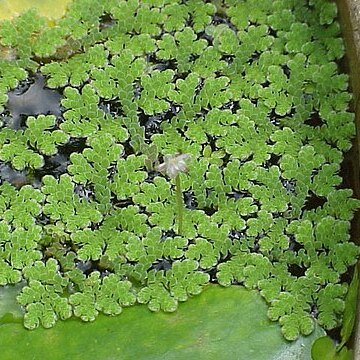Delicate, moss-like plants, subdichotomously branched above every third lf; roots slender, simple, inconspicuous; lvs alternate, minute, sessile, unequally bilobed, one lobe submersed and serving as a float, the other smaller, emersed, and containing a colony of a symbiotic blue-green alga, Anabaena azollae; sporocarps borne on the first leaf of a branch, paired at the tip of a short, bipartite secondary lobe originating from the submersed lobe near its base, appearing almost axillary; microspores 32 or 64, aggregated into 4 or more massulae, each massula with its own thin wall, which bears numerous slender appendages (glochidia) with terminal, retrorse hooks; megaspore with a hemispheric or broadly bell-shaped basal part and a sharply marked, complex, conical terminal part that eventually shows 3 basally spreading, apically confluent, longitudinal valves. 6, cosmop.
Free-floating, aquatic ferns. Stem short, creeping, bearing short roots and sometimes trichomes. Leaves small, imbricate, fleshy; margins transparent, bilobed; upper lobe 1–2 mm long, usually minutely to strongly papillate, lacking veins, containing the cyanobacterium Anabaena azollae in central cavity; lower lobe submerged and bearing 2–4 megasporangia or microsporangia in axils. Megasporocarps oblong-conical, protected by a membrane-like indusium; megaspores solitary; basal portion rounded, smooth, pitted or with raised, hexagonal markings surmounted by 3–9 floats. Microsporocarps ovoid to globular, covered by a transparent indusium; microsporangia 7–100, spherical, stalked, containing 4–10 massulae bearing few to many, hooked or non-hooked, septate or non-septate processes. Microspores 32–64, in groups within massulae.
Floating aquatic ferns with short stems bearing long roots. Lvs monomorphic, c. 0.5-2 mm long, imbricate, lacking veins, 2-lobed; upper lobe green and usually papillate; lower lobe hyaline. Mega-and microsporangia borne separately in stalked sporocarps on the lower lobes of the lvs. Spores trilete.
Leaves less than 1 mm long, bilobed, with one lobe submerged
Characters as for family.
Characters of the family.

